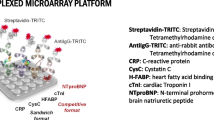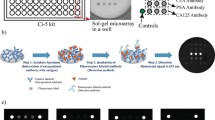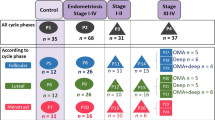Abstract
Objective
Plasminogen activator inhibitor-1 (PAI-1), one crucial component of the plasminogen activator system, is a major player in the pathogenesis of many vascular diseases as well as in cancer. is a major player in the pathogenesis of many vascular diseases as well as in cancer. High levels of PAI-1 in breast cancer tissue are associated with poor prognosis. cancer tissue are associated with poor prognosis. The aim of this study is to evaluate rigorously the potential of serum PAI-1 concentration functioning as a general screening test in diagnostic or prognostic assays. PAI-1 concentration functioning as a general screening test in diagnostic or prognostic assays.
Methods
A protein-microarray-based sandwich fluorescence immunoassay (FIA) was developed to detect PAI-1 in serum. Several conditions of this microarray-based FIA were optimized to establish an efficacious method. Serum specimens of 84 healthy women and 285 women with breast cancer were analyzed using the optimized FIA microarray. specimens of 84 healthy women and 285 women with breast cancer were analyzed using the optimized FIA microarray.
Results
The median serum PAI-1 level of breast cancer patients was higher than that of healthy women (109. p ]The median serum PAI-1 level of breast cancer patients was higher than that of healthy women (109.7 ng/ml vs. 63.4 ng/ml). Analysis of covariance revealed that PAI-1 levels of the two groups were significantly different (P<0. 001) when controlling for an age effect on PAI-1 levels. However, PAI-1 values in TNM stage IIV patients respectively were not significantly different from each other. respectively were not significantly different from each other.
Conclusion
This microarray-based sandwich FIA holds potential for quantitative analysis of tumor markers such as PAI-1. PAI-1.
Similar content being viewed by others
References
Durand MK, Bødker JS, Christensen A, et al. Plasminogen activator inhibitor-I and tumour growth, invasion, and metastasis. Thromb Haemost 2004; 91:438–449.
Look MP, van Putten WL, Duffy MJ, et al. Pooled analysis of prognostic impact of urokinase-type plasminogen activator and its inhibitor PAI-1 in 8377 breast cancer patients. J Natl Cancer Inst 2002; 94:116–128.
Grebenchtchikov N, Maguire TM, Riisbro R, et al. Measurement of plasminogen activator system components in plasma and tumor tissue extracts obtained from patients with breast cancer: an EORTC Receptor and Biomarker Group collaboration. Oncol Rep 2005; 14:235–239.
Palmirotta R, Ferroni P, Savonarola A, et al. Prognostic value of presurgical plasma PAI-1 (plasminogen activator inhibitor-1) levels in breast cancer. Thromb Res 2009; 124:403–408.
Seong SY, Choi CY. Current status of protein chip development in terms of fabrication and application. Proteomics 2003; 3:2176–2189.
Zhu H, Snyder M. Protein chip technology. Curr Opin Chem Biol 2003; 7:55–63.
Templin MF, Stoll D, Schrenk M, et al. Protein microarray technology. Trends Biotechnol 2002; 20:160–166.
Weissenstein U, Schneider MJ, Pawlak M, et al. Protein chip based miniaturized assay for the simultaneous quantitative monitoring of cancer biomarkers in tissue extracts. Proteomics 2006; 6:1427–1436.
Chen H, Jiang C, Yu C, et al. Protein chips and nanomaterials for application in tumor marker immunoassays. Biosens Bioelectron 2009; 24:3399–3411.
Ren F, Zhang QY, Wang YM, Xu JJ. Cloning of human plasminogen activator inhibitor-1 (PAI1) gene and preparation of its monoclonal antibodies as well as its application in detection of PAI1 expression in breast cancer cells. Zhonghua Jian Yan Yi Xue Za Zhi (in Chinese) 2007; 11:1274–1278.
Gonzalez RM, Seurynck-Servoss SL, Crowley SA, et al. Development and validation of sandwich ELISA microarrays with minimal assay interference. J Proteome Res 2008; 7:24062–24014.
Kambhampati D. Protein Microarray Technology. Weinheim: WILEYVCH, 2003
Angleton P, Chandler WL, Schmer G. Diurnal variation of tissue-type plasminogen activator and its rapid inhibitor (PAI-1). Circulation 1989; 79:101–106.
Demirkan B, Ozcan MA, Glu AA, et al. The effect of anthracycline-based (epirubicin) adjuvant chemotherapy on plasma TAFI and PAI-1 levels in operable breast cancer. Clin Appl Thromb Hemost 2006; 12:9–14.
Herszényi L, Farinati F, Cardin R, et al. Tumor marker utility and prognostic relevance of cathepsin B, cathepsin L, urokinase-type plasminogen activator, plasminogen activator inhibitor type-1, CEA and CA 19-9 in colorectal cancer. BMC Cancer 2008; 8:194.
Becker M, Szarvas T, Wittschier M, et al. Prognostic impact of plasminogen activator inhibitor type 1 expression in bladder cancer. Cancer 2010; 116:4502–4512.
Langenskiöld M, Holmdahl L, Angenete E, et al. Differential prognostic impact of uPA and PAI-1 in colon and rectal cancer. Tumour Biol 2009; 30:210–220.
Angenete E, Langenskiöld M, Palmgren I, et al. uPA and PAI-1 in rectal cancer—relationship to radiotherapy and clinical outcome. J Surg Res 2009; 153:46–53.
Yamada Y, Arao T, Matsumoto K, et al. Plasma concentrations of VCAM-1 and PAI-1: a predictive biomarker for post-operative recurrence in colorectal cancer. Cancer Sci 2010; 101:1886–1890.
Vaughan DE, De Taeye BM, Eren M. PAI-1 antagonists: predictable indications and unconventional applications. Curr Drug Targets 2007; 8:962–970.
Author information
Authors and Affiliations
Corresponding author
Additional information
This work was supported by the National “ 863” High Technology Project Found of China (No. 2006AA02A402).
Rights and permissions
About this article
Cite this article
Ma, X., Zhang, Qy. Protein microarrays for quantitative detection of PAI-1 in serum. Chin. J. Cancer Res. 24, 220–225 (2012). https://doi.org/10.1007/s11670-012-0220-x
Received:
Accepted:
Published:
Issue Date:
DOI: https://doi.org/10.1007/s11670-012-0220-x




